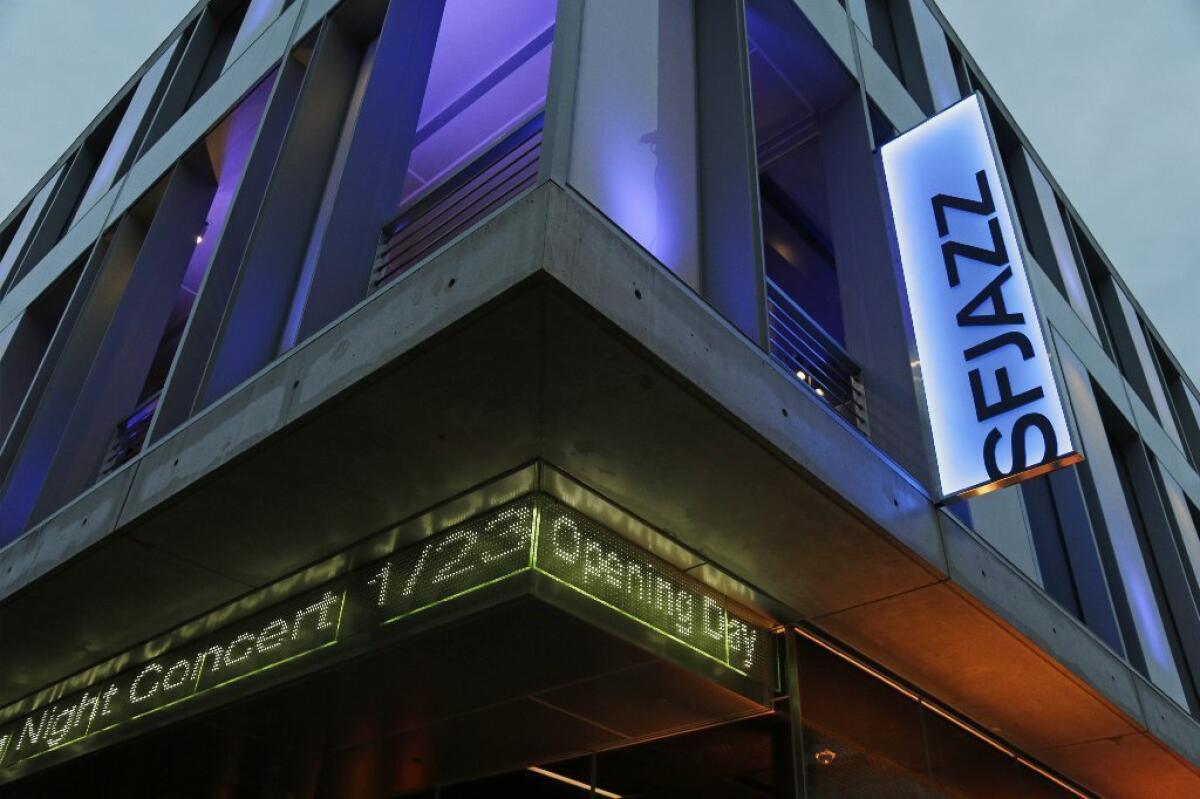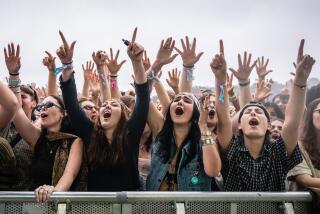SFJAZZ plays another bold riff

SAN FRANCISCO — “This is one of my favorite rooms,” said SFJAZZ founder and Executive Artistic Director Randall Kline, smiling as he stepped over exposed pipes and dusty planks in the SFJAZZ Center. “Then again, they’re all my favorite rooms,” he added.
You’ll forgive Kline for sounding a bit excited. This month, construction on the $63-million SFJAZZ Center will finish with a grand opening scheduled for Jan.21, Martin Luther King Jr. Day. Two days later, a roster of opening-night performers that includes McCoy Tyner, Joshua Redman, Chick Corea and Esperanza Spalding (with Bill Cosby as master of ceremonies) will christen the first SFJAZZ season in the building (though SFJAZZ has been presenting concerts in and around San Francisco for 30 years).
“I think it’s going to be a great thing, not only for the Bay Area but just for music in general to have a space like that,” said New York saxophonist Miguel Zenón, who for nine years has been a member of the SFJAZZ Collective, a sort of musical outreach arm that performs concerts nationwide. SFJAZZ isn’t “going to just go through the motions and book the same people every time, or book whoever’s hot,” he said. “They’re really into presenting new music and giving people a sense of what’s happening.”
2012 in review: L.A.’s top 10 arts and culture stories
At 35,000 square feet, the center is the first free-standing hall of its kind built exclusively for jazz, and its debut comes at a time when presenting live music — and jazz in particular — could be considered a risky proposition. A tough economic climate has seen clubs closing around the country, including Los Angeles with the still-itinerant Jazz Bakery (whose ambitious plans for a new, Frank Gehry-designed Culver City home in some ways mirrors aspects of the SFJAZZ Center). The same applies to San Francisco, where the city’s second location of the venerable Oakland jazz club, Yoshi’s, filed a petition for involuntary bankruptcy in November.
Despite his contagious air of optimism and excitement while touring his new facility, Kline is aware of the challenges ahead.
“‘Terrified’ is a good word,” Kline playfully admitted at a restaurant a half a block away from the center, situated in the vibrant Hayes Valley neighborhood not far from City Hall. Kline worked at the Boarding House, a San Francisco club that hosted the Wailers, Janis Ian and Steve Martin, in the ‘70s before starting SFJAZZ as a two-day festival called Jazz in the City in 1982. “When we decided to do this project it was 2006 or 2007 — the whole world fell apart in 2008 as we were going into this. And the fact we raised most of the money for this — we’re now at 57 and a quarter million, in a time of the worst economic times in San Francisco — where else could something like this happen?”
Watching a sold-out Herbst Theatre revel in a performance by Mallorca-raised singer Buika around the corner later that night, you begin to understand Kline’s point. Presented by SFJAZZ, the show dipped into Flamenco and Gypsy music while brushing into Latin jazz, and the crowd hung on the magnetic singer’s every word, even as she grinned through rapid-fire asides in her native Spanish.
The concert reflected an eclectic program that’s been in place since the beginnings of SFJAZZ as an annual concert series, which booked Tony Bennett alongside a tribute to John Coltrane. The organization offers a broader vision for the music than its analogue in New York City, Jazz at Lincoln Center, which for years was criticized for its rigid view of what could be considered jazz. Another SFJAZZ-presented show in the ‘90s, a far-out night with Ornette Coleman that featured live body piercing, received plenty of criticism but remained consistent with San Francisco’s history of free-spirited happenings.
The philosophy extends to SFJAZZ’s varied resident artistic director program, which allows artists to experiment with different programs during a run of shows. This year’s roster includes guitarist Bill Frisell performing a multimedia piece inspired by Hunter S. Thompson and pianist Jason Moran improvising alongside pro skateboarders riding a half-pipe that will be assembled near the stage.
“That’s the whole idea here — what can you do to create better context for people to experience the music?” Kline asked. “If one thinks that jazz is something you have to know a lot about and get over a hurdle, well, it doesn’t have to be all jazz you’re going to hear in there to get you in the building.
“A little bit of context goes a long, long way,” he added. “So if you know a little about history or theory, it doesn’t take much to learn it. It isn’t a lifelong course to understand jazz; it could probably be 20 minutes.”
The center’s considerable journey from project to reality was sped along by a lead gift of $20 million from an anonymous donor. This allowed the nonprofit SFJAZZ to set aside early plans to partner with other arts presenters in the city and pursue a home of its own instead. In the design, an effort was made to give SFJAZZ’s inclusive philosophy a physical form.
Sheathed in glass at ground level, the center reflects Kline’s vision for a cultural institution open to the whole city. That favorite room still taking shape during the tour in November? It was the Ensemble Room, an 80-seat space that will also offer intimate performances from smaller acts as well as clinics and workshops. The space will be visible to those on Franklin Street outside.
This ground-floor meeting point between the city and the institution was key for Kline, who envisioned a feeling of the sidewalk merging with the inside of the center.
“The conceit of building is an openness to the street, making the art feel accessible to the community,” Kline said, referencing the glass-walled design that also echoes the Allen Room in Jazz at Lincoln Center’s home, which features a floor-to-ceiling window overlooking Central Park. “We want people to experience what’s happening here, even if they’re not in it.”
The idea extends to the center’s main performance space in the Robert N. Miner Auditorium. The latter features a piano positioned just so onstage, giving onlookers on neighboring Fell Street a chance to see part of any given performance. It’s a nod to a feature at the Giants’ home at AT&T; Park, where fans can get a distant view of a few innings without buying a ticket. (Prices for many shows at SFJAZZ begin at $20, with an option to become a member to receive discounts on select concerts and eliminate ticket service fees.)
The center has met its goal of being based in a “place that has life” as well as nearby access to public transit. It’s also near established institutions such as the Herbst Theatre and Davies Symphony Hall, a perk for SFJAZZ that makes it, in Kline’s words, “even hipper.” But he adds that the aims of the SFJAZZ Center are “different from being a bastion of culture, built at a time when being imposing was part of the shtick,” he explained. “We’re building a culture of what’s now.”
“The building is very much something that’s a reflection of who’s in it and what’s going on inside; there’s no departing from that,” said architect Mark Cavagnero, drawing a comparison with the more imposing look of the center’s neighbors. Designer of several Bay Area arts institutions including the Community School of Music and Arts in Mountain View and an expansion of the Oakland Museum of California, Cavagnero added that the goal was “making a building that was so transparent and people would just be drawn in with no boundaries, no thresholds, and they could come by and say, ‘Gee, one of these days I’m going to buy a ticket and see what it’s all about. It looks fun, it looks interesting. I can see myself in that space.’”
Just over a mile away in the city’s Fillmore District, the contrast between the ideas of the SFJAZZ Center and the troubled Yoshi’s San Francisco is striking. A glossy, high-end hybrid of a restaurant, cocktail lounge and jazz club, Yoshi’s is all swooping lines, high ceilings and an almost alarming amount of square footage. “Yep, industrial jazz,” someone behind the bar smirks when the room’s cavernous size is mentioned, a trait that becomes more apparent on a sparsely attended Friday night, which kept an upstairs sake lounge from even being opened.
With the SFJAZZ Center’s opening weeks away, Yoshi’s manager that night, Beniyam “Benny” Kebede, sounded equal parts optimistic and realistic. “It might draw some of our business away, but we’re not thinking straight-ahead jazz so much,” he said as a suit-clad Jeff Hamilton Trio gamely chugged through standards in the performance space around the corner and down a narrow hallway from the bar. “They don’t book R&B; or smooth jazz, which we do, so that kind of gives us a leg up.
“We’re trying to reach a younger crowd,” Kebede said, and explained that recent comedy shows with Dave Chappelle and Robin Williams have sold well. “We’re open to trying different things. Although it is Yoshi’s Jazz Club — we try and stay true to who we are.”
Reaching a new audience is a key part of what Kline sees as the mission of SFJAZZ, and it manifests in the main performance hall, which places intimacy at a premium with a maximum of 700 seats, and customizability that allows for seats to be removed to accommodate a dance floor for more groove-oriented acts such as Medeski Martin and Wood or be divided by curtains to make the space more intimate.
“What Randall was really after is something that had performance quality and focus of a great music hall but the intimacy, the warmth, the vibrancy of the club,” said Cavagnero, who added that he also hoped to set aside the feeling of a conventional theater and an “us versus them” barrier between musician and audience with the room’s sight lines. “Each time you’re viewing the performer you’re looking across the stage and seeing audience on the other side, so you’re kind of enveloping their energy, right? You are intimately aware that you are in a room of like-minded people,” he explained.
Walking through the construction site, Kline excitedly talks about the efforts taken to build the room’s acoustics as well as the possibilities in lighting and projections behind the stage. “I’m feeling very kidlike, the idea of these little things we’re talking about,” Kline said.
But despite all the talk of the technology behind the SFJAZZ Center’s acoustics, modern lighting and performance space, Kline described his goals as something much simpler. “Part of this is really a return to a much more primitive thing. ... The design of the theater is really gathering around the fire. You’ve got this space in the middle and everyone is around it, and you see everybody else and they’re having an experience together. It’s a much more primal thing that we’re doing in a contemporary manner,” he said.
“So,” he added with a laugh, “hopefully it can work.”
PHOTOS AND MORE
COACHELLA: Complete 2013 lineup
THE ENVELOPE: Awards Insider
PHOTOS: Grammy top winners
More to Read
The biggest entertainment stories
Get our big stories about Hollywood, film, television, music, arts, culture and more right in your inbox as soon as they publish.
You may occasionally receive promotional content from the Los Angeles Times.











